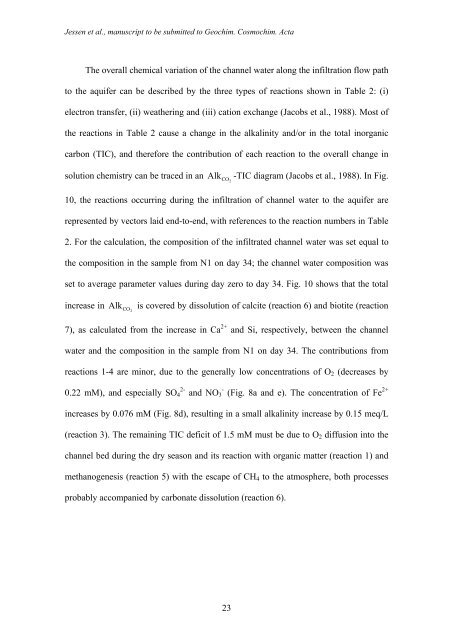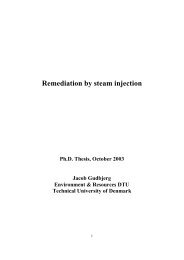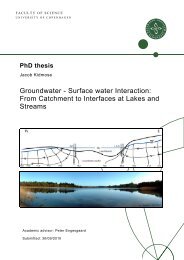Groundwater arsenic in the Red River delta, Vietnam ... - Fiva
Groundwater arsenic in the Red River delta, Vietnam ... - Fiva
Groundwater arsenic in the Red River delta, Vietnam ... - Fiva
Create successful ePaper yourself
Turn your PDF publications into a flip-book with our unique Google optimized e-Paper software.
Jessen et al., manuscript to be submitted to Geochim. Cosmochim. Acta<br />
The overall chemical variation of <strong>the</strong> channel water along <strong>the</strong> <strong>in</strong>filtration flow path<br />
to <strong>the</strong> aquifer can be described by <strong>the</strong> three types of reactions shown <strong>in</strong> Table 2: (i)<br />
electron transfer, (ii) wea<strong>the</strong>r<strong>in</strong>g and (iii) cation exchange (Jacobs et al., 1988). Most of<br />
<strong>the</strong> reactions <strong>in</strong> Table 2 cause a change <strong>in</strong> <strong>the</strong> alkal<strong>in</strong>ity and/or <strong>in</strong> <strong>the</strong> total <strong>in</strong>organic<br />
carbon (TIC), and <strong>the</strong>refore <strong>the</strong> contribution of each reaction to <strong>the</strong> overall change <strong>in</strong><br />
solution chemistry can be traced <strong>in</strong> an AlkCO -TIC diagram (Jacobs et al., 1988). In Fig.<br />
2<br />
10, <strong>the</strong> reactions occurr<strong>in</strong>g dur<strong>in</strong>g <strong>the</strong> <strong>in</strong>filtration of channel water to <strong>the</strong> aquifer are<br />
represented by vectors laid end-to-end, with references to <strong>the</strong> reaction numbers <strong>in</strong> Table<br />
2. For <strong>the</strong> calculation, <strong>the</strong> composition of <strong>the</strong> <strong>in</strong>filtrated channel water was set equal to<br />
<strong>the</strong> composition <strong>in</strong> <strong>the</strong> sample from N1 on day 34; <strong>the</strong> channel water composition was<br />
set to average parameter values dur<strong>in</strong>g day zero to day 34. Fig. 10 shows that <strong>the</strong> total<br />
<strong>in</strong>crease <strong>in</strong> Alk CO is covered by dissolution of calcite (reaction 6) and biotite (reaction<br />
2<br />
7), as calculated from <strong>the</strong> <strong>in</strong>crease <strong>in</strong> Ca 2+ and Si, respectively, between <strong>the</strong> channel<br />
water and <strong>the</strong> composition <strong>in</strong> <strong>the</strong> sample from N1 on day 34. The contributions from<br />
reactions 1-4 are m<strong>in</strong>or, due to <strong>the</strong> generally low concentrations of O2 (decreases by<br />
0.22 mM), and especially SO4 2- and NO3 - (Fig. 8a and e). The concentration of Fe 2+<br />
<strong>in</strong>creases by 0.076 mM (Fig. 8d), result<strong>in</strong>g <strong>in</strong> a small alkal<strong>in</strong>ity <strong>in</strong>crease by 0.15 meq/L<br />
(reaction 3). The rema<strong>in</strong><strong>in</strong>g TIC deficit of 1.5 mM must be due to O2 diffusion <strong>in</strong>to <strong>the</strong><br />
channel bed dur<strong>in</strong>g <strong>the</strong> dry season and its reaction with organic matter (reaction 1) and<br />
methanogenesis (reaction 5) with <strong>the</strong> escape of CH4 to <strong>the</strong> atmosphere, both processes<br />
probably accompanied by carbonate dissolution (reaction 6).<br />
23





